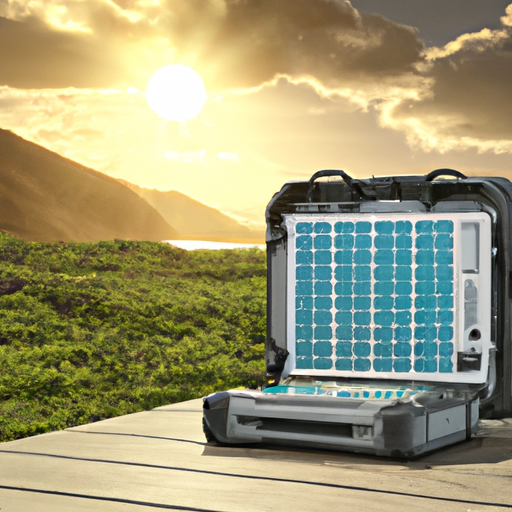

Are you wondering if those portable solar generators can actually power your energy-hungry appliances? Well, you’ve come to the right place! In this article, we’ll dive into the world of portable solar generators and whether they can handle the high energy demands of your appliances.
So, let’s talk about portable solar generators. These nifty devices harness the power of the sun to generate electricity, giving you a portable and eco-friendly source of energy. They come in various sizes and can be useful for a range of applications, from camping trips to emergency situations. Now, you’re probably wondering if they can handle the power needs of appliances like your refrigerator, air conditioner, or even a power-hungry gaming setup.
The short answer is that it depends on the specific portable solar generator you have and the energy requirements of your appliances. While some portable solar generators can handle the power demands of high-energy appliances, others may not have the capacity. It’s important to consider factors like the wattage and battery capacity of the generator, as well as the energy consumption of your appliances. In our upcoming article, we’ll delve deeper into these considerations and provide you with some tips on how to choose the right portable solar generator for your high-energy needs. Stay tuned to learn more!


Overview
What are portable solar generators?
Portable solar generators are devices that convert solar energy into electrical energy, which can be used to power various appliances and devices. Unlike traditional generators that rely on fuel or electricity from the grid, portable solar generators harness the power of the sun to generate clean and renewable energy. These generators are typically compact and lightweight, making them convenient for outdoor activities, camping trips, or as a backup power source during emergencies.
How do portable solar generators work?
Portable solar generators consist of solar panels, a charge controller, a battery bank, and an inverter. The solar panels capture sunlight and convert it into DC (direct current) electrical energy. The charge controller regulates the flow of electricity from the solar panels to the battery bank, ensuring that it is charged efficiently and safely. The battery bank stores the excess energy generated by the solar panels for later use. Finally, the inverter converts the DC electricity stored in the battery bank into AC (alternating current) electricity, which is suitable for powering appliances and devices.
Benefits of using portable solar generators
There are several benefits to using portable solar generators, especially for powering appliances with high energy demands. First and foremost, they provide a reliable source of power that is independent of the electrical grid. This is particularly useful in remote locations or during power outages when access to traditional sources of electricity may be limited or unavailable.
Additionally, portable solar generators produce clean and renewable energy, helping to reduce carbon emissions and minimize environmental impact. They are also virtually silent when in operation, making them ideal for outdoor activities or situations where noise levels need to be kept to a minimum.
Furthermore, portable solar generators offer cost savings in the long run. While the initial investment may be higher compared to traditional generators, there are no ongoing fuel costs, and maintenance requirements are minimal. This makes them a more cost-effective solution, especially over the lifetime of the generator.
Powering Appliances with High Energy Demands
Understanding high energy demands
Certain appliances and devices require a significant amount of energy to operate effectively. These appliances typically have high power ratings, measured in watts, and may require a constant power supply to function properly. Examples of appliances with high energy demands include air conditioners, refrigerators, electric stoves, washing machines, and power tools. It is important to consider these high energy demands when evaluating the suitability of portable solar generators for powering such appliances.
Types of appliances with high energy demands
Appliances with high energy demands can be categorized into two main types: resistive loads and inductive loads. Resistive loads, such as electric stoves and power tools, consume a steady amount of power and are generally easier to power with a portable solar generator. Inductive loads, such as air conditioners and refrigerators, have fluctuating power consumption due to their compressors and motors. These types of appliances can pose a greater challenge when it comes to powering them with a portable solar generator.
Challenges in powering appliances with high energy demands
One of the main challenges in powering appliances with high energy demands using portable solar generators is the limited power output of the generators themselves. Portable solar generators typically have a maximum power output ranging from a few hundred watts to several kilowatts, depending on their size and capacity. This may not be sufficient to meet the energy requirements of appliances with high power ratings.
Another challenge is the intermittent nature of solar energy. The power generation of solar panels is dependent on sunlight, meaning that the output of a portable solar generator will vary throughout the day and may be affected by weather conditions. This can make it difficult to consistently provide the necessary power for appliances with high energy demands.
Suitability of Portable Solar Generators
Assessing power output of portable solar generators
When considering the suitability of portable solar generators for powering appliances with high energy demands, it is important to assess the power output of the generator. This information is typically provided by the manufacturer and is measured in watts or kilowatts. It is crucial to match the power output of the generator with the power requirements of the appliances you intend to power.
Matching energy requirements of appliances
To determine if a portable solar generator can effectively power appliances with high energy demands, it is necessary to calculate the energy requirements of the appliances in question. This involves considering the power rating of the appliances (in watts), the duration of use (in hours), and any additional power needed to start up certain appliances (known as surge power).
It is important to note that the power rating of an appliance is usually listed on the label or in the user manual. By summing up the power requirements of all the appliances, you can determine if the portable solar generator has sufficient power output to meet your needs.
Considerations for using portable solar generators with high energy demand appliances
When using a portable solar generator to power appliances with high energy demands, it is important to consider several factors. Firstly, you should prioritize and stagger the usage of appliances to avoid exceeding the power output of the generator. This means using energy-intensive appliances one at a time or in a sequence, rather than all at once.
Secondly, efficient energy management techniques should be employed. This involves using energy-efficient appliances, minimizing standby power consumption, and adopting energy-saving practices. By reducing overall energy consumption, you can maximize the usability and efficiency of the portable solar generator.
Lastly, it may be beneficial to invest in additional energy storage systems. These systems, such as larger battery banks or external battery packs, can store excess energy generated by the solar panels during peak sunlight hours. This stored energy can then be utilized during periods of low sunlight or increased energy demands, providing a more consistent power supply for appliances with high energy demands.


Optimizing the Use of Portable Solar Generators
Efficient energy management techniques
To optimize the use of a portable solar generator, it is important to practice efficient energy management techniques. This involves being mindful of energy consumption and making conscious efforts to reduce waste. For example, turning off lights and appliances when they are not in use, using energy-efficient appliances, and utilizing natural lighting and ventilation whenever possible.
Using energy storage systems
In addition to efficient energy management, utilizing energy storage systems can significantly optimize the use of a portable solar generator. Energy storage systems, such as battery banks or external battery packs, allow for the storage of excess energy generated by the solar panels. This stored energy can then be used during periods of low sunlight or increased energy demands, ensuring a more consistent power supply for appliances with high energy demands.
Utilizing solar tracking technology
Another way to optimize the use of a portable solar generator is by utilizing solar tracking technology. Solar tracking systems automatically adjust the position of solar panels to maximize their exposure to sunlight throughout the day. This can increase the overall energy output of the solar panels and improve the efficiency of the portable solar generator.
Best Practices for Powering Appliances
Prioritizing appliance usage
To effectively power appliances with a portable solar generator, it is important to prioritize their usage. Determine which appliances are essential and prioritize their power consumption over non-essential appliances. This ensures that the limited power output of the generator is allocated to the most important appliances first.
Managing energy consumption
Managing energy consumption is crucial when using a portable solar generator to power appliances with high energy demands. This involves being mindful of energy-intensive activities and making conscious efforts to reduce energy usage. For example, using energy-efficient appliances, adjusting temperature settings, and minimizing standby power consumption can all contribute to more efficient energy management.
Monitoring and maintaining portable solar generators
Regular monitoring and maintenance of portable solar generators are essential for their optimal performance and longevity. This includes regularly checking the solar panels for dirt or debris that may hinder their efficiency, ensuring proper functioning of the charge controller and inverter, and inspecting the battery bank for any signs of damage or deterioration. Following the manufacturer’s guidelines for maintenance and scheduling routine inspections can help prevent issues and ensure the reliable operation of the portable solar generator.
Case Studies
Successful examples of powering high energy demand appliances with portable solar generators
Several case studies have demonstrated the successful use of portable solar generators to power appliances with high energy demands. For example, in remote areas where access to the electrical grid is limited, portable solar generators have been used to power refrigeration units for storing vaccines and medications. In off-grid homes, portable solar generators have been utilized to power air conditioning units and essential kitchen appliances.
Lessons learned and recommendations from case studies
From these case studies, several lessons can be learned and recommendations can be made for the successful implementation of portable solar generators for high energy demand appliances. It is important to carefully assess the power requirements of the appliances and choose a portable solar generator with sufficient power output. Additionally, efficient energy management and usage prioritization are key to ensuring a consistent power supply for high energy demand appliances.
Comparison with Other Power Sources
Pros and cons of using portable solar generators compared to traditional power sources
When comparing portable solar generators to traditional power sources, such as fuel-based generators or electricity from the grid, there are several pros and cons to consider. Portable solar generators offer the advantage of clean and renewable energy, reducing carbon emissions and minimizing environmental impact. They are also quieter and require minimal maintenance compared to fuel-based generators.
However, portable solar generators may have limited power output and are dependent on sunlight for energy generation. This can pose challenges in consistently meeting the energy requirements of appliances with high energy demands, especially in areas with limited sunlight or during periods of inclement weather.
Cost-effectiveness and sustainability considerations
In terms of cost-effectiveness, portable solar generators can provide long-term savings compared to traditional power sources. While the initial investment may be higher, there are no ongoing fuel costs, and maintenance requirements are minimal. In addition, portable solar generators offer a sustainable and environmentally friendly solution, promoting the use of clean and renewable energy sources.
Future Possibilities and Advancements
Emerging technologies in portable solar generators
The field of portable solar generators is continuously evolving, with emerging technologies aimed at improving their power output and efficiency. For example, advancements in solar panel technology, such as the use of high-efficiency solar cells and thin-film solar panels, can enhance the energy generation capabilities of portable solar generators. Additionally, the development of lightweight and flexible solar panels allows for increased portability and versatility.
Potential improvements in power output and efficiency
As research and development in the field of portable solar generators continue, it is likely that improvements in power output and efficiency will be achieved. This may involve advancements in solar panel materials and technologies, more efficient charge controllers and inverters, as well as the integration of smart grid technologies for better energy management.
Advancements in energy storage systems
Energy storage systems play a crucial role in optimizing the use of portable solar generators. Advancements in battery technologies, such as the development of more efficient and longer-lasting lithium-ion batteries, can enhance the storage capacity and overall performance of portable solar generators. Additionally, the integration of advanced energy management systems, such as artificial intelligence and machine learning algorithms, can optimize the usage and storage of energy.
Environmental Impact
Reducing carbon footprint
One of the key environmental benefits of using portable solar generators is the reduction in carbon footprint. By utilizing clean and renewable solar energy, portable solar generators minimize the reliance on fossil fuels and decrease the emission of greenhouse gases. This helps to mitigate climate change and protect the environment for future generations.
Promoting clean and renewable energy
Another significant environmental impact of portable solar generators is the promotion of clean and renewable energy sources. By harnessing the power of the sun, these generators contribute to a more sustainable energy landscape and reduce dependency on non-renewable resources. This promotes a shift towards a cleaner and greener energy future.
Benefits for off-grid lifestyles
Portable solar generators are particularly beneficial for those living in off-grid locations or pursuing an off-grid lifestyle. In remote areas, it can be challenging to access traditional sources of electricity, making portable solar generators an ideal solution. By providing a reliable and sustainable source of power, these generators enable individuals to live independently and comfortably, irrespective of their geographical location.
Conclusion
In conclusion, while portable solar generators have their limitations, they can be used to power appliances with high energy demands under certain circumstances. To determine the suitability of a portable solar generator, it is important to assess the power output of the generator and compare it with the energy requirements of the appliances. Efficient energy management, the use of energy storage systems, and solar tracking technology can optimize the use of portable solar generators.
By prioritizing appliance usage, managing energy consumption, and properly monitoring and maintaining the generator, successful implementation is possible. While portable solar generators have pros and cons compared to traditional power sources, they offer several benefits, including reduced carbon footprint, clean and renewable energy, and cost-effectiveness.
With emerging technologies and advancements in energy storage systems, the future of portable solar generators looks promising. These advancements will likely lead to improvements in power output and efficiency, further enhancing their potential to power appliances with high energy demands. Ultimately, the viability of using portable solar generators for such appliances depends on careful assessment, efficient energy management, and the individual’s specific energy requirements.



